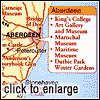|
The Moray Coast
Fochabers is the next town 8 miles (13km) northwest on
the River Spey and a final staging post on the Speyside Way walking route.
Fochabers Folk Museum has a large collection of horse-drawn
vehicles and a reconstructed village shop along with a multitude of early domestic
items.
Most travellers stop at the Baxter's Visitor Centre
on the north edge of town, impossible to miss and a masterpiece of modern marketing
for the humble can of soup. The history of the family, who still own and run the
company, is appealing with George Baxter, a gardener at Gordon Castle in the 1870s
opening a grocer's shop in Fochabers that sold his wife's home-made preserves. From
this modest start a world-wide business in quality, canned products has grown and
kept pace with modern demands.
There is an introductory video before a tour of the
factory, a Victorian kitchen, ye olde shoppe and a gift shop to purchase the stock.
A short detour north to the coast on the B9104 brings
you to the sleepy hamlet of Spey Bay. Although, at first glance, there appears little
to do, there is an 18 hole golf course, driving range, petanque court, tennis courts
and fishing at the mouth of the famous Spey River, all surrounding the Spey Bay Hotel
and Caravan Site, a self-contained little hide-away.
Elgin
Elgin is 9 miles (14km) west of Fochabers and the
main centre for this region of Moray.
 On the banks of the River Lossie, it is a lively little town
set in good order with some interesting ancient buildings, plenty of shopping and
several places worth seeing. In July it holds its Highland Games and, in September,
a famous Fiddlers Rally. Elgin Museum in the High Street is particularly well laid
out and has recently won the Museum of the Year award. On the banks of the River Lossie, it is a lively little town
set in good order with some interesting ancient buildings, plenty of shopping and
several places worth seeing. In July it holds its Highland Games and, in September,
a famous Fiddlers Rally. Elgin Museum in the High Street is particularly well laid
out and has recently won the Museum of the Year award.
Nearby, Elgin Cathedral was founded in 1224, creating
a religious centre almost as important as St Andrews and Dunfermline. This building,
like all Scottish cathedrals, bore the wrath of King Edward I and later, in 1650,
the wanton vandalism of Cromwell's troops. Restoration began in 1825 and still continues
today. A solitary Pictish stone slab stands in the middle of the ruin.
A Cashmere Visitor Centre exists at Newmill near the
cathedral where Johnston's of Elgin have set up facilities to allow a tour of the
mill as well as an audio visual presentation and coffee shop. Moray Motor Museum
is in Bridge Street with a collection of ancient but gleaming means of transport
including a 1914 Renault and a 1929 Rolls Royce Phantom.
Lossiemouth
Directly north of Elgin, towards the coast, is Lossiemouth,
a popular holiday resort with extensive sandy beaches either side of the town. Sea
angling is popular and it has one of the best 18-hole golf courses in an area renowned
for good links courses. Golfers have reported bouncing balls off Royal Air Force
fighters as they land at the nearby airfield but this might be an over-exaggeration
of their driving prowess.
Lossiemouth is the birthplace of Ramsay MacDonald,
the UK's first Labour Prime Minister, born here in 1866. Lossiemouth Fishery and
Community Museum is found in Pitgaveny Street with scale models of fishing vessels
and a reconstruction of Ramsay MacDonald's study with some of the original furnishings.
South-west of Elgin on minor roads near the Black
Burn is Pluscarden Abbey, a priory founded by King Alexander II in 1230 for a French
order of monks. It was given to a Benedictine community in 1948 when restoration
began. Pluscarden was elevated to the status of Abbey in 1974.
Forres
Forres is a well ordered little town well known for
its topiary-adorned gardens in Grant Park. It has been an established settlement
for at least 2,000 years as it appears on maps of that time.
 Forres was once popular as a spa town but that has been replaced
with its reputation for beautiful gardens. Overlooking the town is Nelson's Tower,
erected in 1806 and recently refurbished, celebrating Nelson's victory at Trafalgar.
The Falconer Museum in Tolbooth Street was founded in 1870 to display the town's
history with changing temporary exhibitions throughout the year and a dedication
to one of Scotland's best loved folk singers, the late Roy Williamson of the Corries. Forres was once popular as a spa town but that has been replaced
with its reputation for beautiful gardens. Overlooking the town is Nelson's Tower,
erected in 1806 and recently refurbished, celebrating Nelson's victory at Trafalgar.
The Falconer Museum in Tolbooth Street was founded in 1870 to display the town's
history with changing temporary exhibitions throughout the year and a dedication
to one of Scotland's best loved folk singers, the late Roy Williamson of the Corries.
On the north-eastern side of town stands Stone, a
23ft (7m) glass encased Pictish stone, age unknown though probably not less than
1,000 years old. It is thought to commemorate a victory over Norse invaders. In Victoria
Road is the Witches Stone, also dating from Pictish times and marking the resting-place
of one of three barrels in which three witches were rolled down the Cluny Hill.
Heading towards the coast on the B9011 is the sailing
village of Findhorn set along the mouth of the river of the same name. This area
is probably best known for the Findhorn Foundation, renowned in the 1970's for producing
gigantic vegetables. It is still an international spiritual community, founded in
1962 by Peter and Eileen Caddy and Dorothy MacLean. Their vision of a better society,
which commenced in a caravan site and has expanded into a 'New Age' and much respected
centre for personal advancement, attracts aspirants from around the globe. Most areas
in the complex are open to visitors and there are presentations on the work and aims
of the community as well as a fascinating bookshop.
Brodie Castle is 3 miles (5km) west of Forres, the
home of the Brodie family since 1160 and now controlled by the National Trust for
Scotland. It contains a fine collection of furniture and paintings with its gardens
noted for their daffodil displays in spring. There is an excellent gift shop and
restaurant by the side of the A96 leading to woodland walks and the castle.
Aberdeen to MacDuff
If you are touring from Aberdeen, an alternative route
to the one just described is to take the A947, running from Aberdeen to MacDuff and
along the Moray coast. Oldmeldrum is 18 miles (29km) out of Aberdeen and 3 miles
further east is Pitmedden Garden and Museum of Farm Life. Alternatively you can follow
the B999 which branches off the A92 north of Bridge of Don.
The gardens were commenced in 1675 by Alexander Seton;
formerly Lord Pitmedden before his title was removed for his opposition to King James
VII's Catholicism. The geometric, boxhedge enclosed, split-level gardens each have
an elaborate and colourful design copied from gardens in Edinburgh's Holyrood Palace
in the 1640s.
The National Trust for Scotland took over and restored
the gardens to their original state in 1952. Forty thousand plants are needed every
year to form the design traced out by 3 miles (5km) of boxwood hedge. At the entrance
is the Museum of Farming Life with the tools once used by the estate workers.

A mile or so north and west of Pitmedden, following
a simple track, is Tolquhon Castle, a medieval remnant now ruined but once the pride
of the Forbes family. There is an art gallery and gift shop along the track.
Haddo House is 4 miles (6km) north on the B999, was
commenced in 1732 by William Adam, father of the famous Adam brothers, the preferred
architect of the period. Many an important visitor has arrived at the foot of the
sweeping steps of Haddo House and royal visitors today such as Prince Edward still
use it for overnight stays.
The avenue leading from the house to the deer park
was planted to commemorate Queen Victoria's visit and it is a Scott's Mile long which
is 200 yards longer than the English mile although, before you adjust your calculations,
this no longer applied. There is a tea-room with home-made baking.
The chapel, built in 1881, was a later edition and
houses a particularly fine pipe organ built by Father Henry Willis, one of the most
famous organ builders of his day and worth closer inspection. There is a new theatre
added to the side of the house for productions of operas and concerts.
Six miles (l0km) north of Haddo near the A947 is Fyvie
Castle, one of the most spectacular castles in Scotland. The castle dates from the
thirteenth century and has been owned by various families through its existence.
The five soaring towers represent each of the ruling
dynasties of Fyvie lairds. Its imposing ochre facade has been described as 'the crowning
glory of Scottish Baronial architecture', much spruced up by Alexander Forbes-Leith
who made his fortune in the American steel industry of the late nineteenth century
and bought the estate in 1889.
The interior was largely his responsibility also,
adorning it with treasures from around the world. There are twelve works by Sir Henry
Raeburn, a Gainsborough portrait and other works by Romney, Opie and Pompeo Batoni
including his portrait of Colonel William Gordon.
The elegant dining room is often used for highbrow
entertainment such as classical music recitals. By way of contrast on such occasions,
pipers sometimes play outside. A few miles further north is the town of Turriff once
a Pictish capital with the annual Turriff Show held in August.
|



